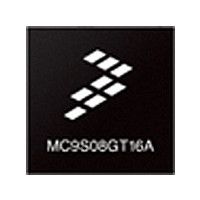MC9S08GT16CFB Freescale Semiconductor, MC9S08GT16CFB Datasheet - Page 253

MC9S08GT16CFB
Manufacturer Part Number
MC9S08GT16CFB
Description
Manufacturer
Freescale Semiconductor
Datasheet
1.MC9S08GT16CFB.pdf
(290 pages)
Specifications of MC9S08GT16CFB
Cpu Family
HCS08
Device Core Size
8b
Frequency (max)
20MHz
Interface Type
SCI/SPI
Program Memory Type
Flash
Program Memory Size
16KB
Total Internal Ram Size
1KB
# I/os (max)
36
Number Of Timers - General Purpose
4
Operating Supply Voltage (typ)
2.5/3.3V
Operating Supply Voltage (max)
3.6V
Operating Supply Voltage (min)
2.08V
On-chip Adc
8-chx10-bit
Instruction Set Architecture
CISC
Operating Temp Range
-40C to 85C
Operating Temperature Classification
Industrial
Mounting
Surface Mount
Pin Count
44
Package Type
PQFP
Lead Free Status / Rohs Status
Not Compliant
Available stocks
Company
Part Number
Manufacturer
Quantity
Price
Company:
Part Number:
MC9S08GT16CFBE
Manufacturer:
FREESCALE
Quantity:
1 831
Company:
Part Number:
MC9S08GT16CFBE
Manufacturer:
Freescale Semiconductor
Quantity:
10 000
Part Number:
MC9S08GT16CFBE
Manufacturer:
FREESCALE
Quantity:
20 000
Company:
Part Number:
MC9S08GT16CFBER
Manufacturer:
Freescale Semiconductor
Quantity:
10 000
- Current page: 253 of 290
- Download datasheet (2Mb)
Registers and Control Bits
15.5.3.5 Debug FIFO High Register (DBGFH)
This register provides read-only access to the high-order eight bits of the FIFO. Writes to this register have
no meaning or effect. In the event-only trigger modes, the FIFO only stores data into the low-order byte of
each FIFO word, so this register is not used and will read $00.
Reading DBGFH does not cause the FIFO to shift to the next word. When reading 16-bit words out of the
FIFO, read DBGFH before reading DBGFL because reading DBGFL causes the FIFO to advance to the
next word of information.
15.5.3.6 Debug FIFO Low Register (DBGFL)
This register provides read-only access to the low-order eight bits of the FIFO. Writes to this register have
no meaning or effect.
Reading DBGFL causes the FIFO to shift to the next available word of information. When the debug
module is operating in event-only modes, only 8-bit data is stored into the FIFO (high-order half of each
FIFO word is unused). When reading 8-bit words out of the FIFO, simply read DBGFL repeatedly to get
successive bytes of data from the FIFO. It isn’t necessary to read DBGFH in this case.
Do not attempt to read data from the FIFO while it is still armed (after arming but before the FIFO is filled
or ARMF is cleared) because the FIFO is prevented from advancing during reads of DBGFL. This can
interfere with normal sequencing of reads from the FIFO.
Reading DBGFL while the debugger is not armed causes the address of the most-recently fetched opcode
to be stored to the last location in the FIFO. By reading DBGFH then DBGFL periodically, external host
software can develop a profile of program execution. After eight reads from the FIFO, the ninth read will
return the information that was stored as a result of the first read. To use the profiling feature, read the FIFO
eight times without using the data to prime the sequence and then begin using the data to get a delayed
picture of what addresses were being executed. The information stored into the FIFO on reads of DBGFL
(while the FIFO is not armed) is the address of the most-recently fetched opcode.
MC9S08GB/GT Data Sheet, Rev. 2.3
Freescale Semiconductor
253
Related parts for MC9S08GT16CFB
Image
Part Number
Description
Manufacturer
Datasheet
Request
R
Part Number:
Description:
Manufacturer:
Freescale Semiconductor, Inc
Datasheet:
Part Number:
Description:
Manufacturer:
Freescale Semiconductor, Inc
Datasheet:
Part Number:
Description:
Manufacturer:
Freescale Semiconductor, Inc
Datasheet:
Part Number:
Description:
Manufacturer:
Freescale Semiconductor, Inc
Datasheet:
Part Number:
Description:
Manufacturer:
Freescale Semiconductor, Inc
Datasheet:
Part Number:
Description:
Manufacturer:
Freescale Semiconductor, Inc
Datasheet:
Part Number:
Description:
Manufacturer:
Freescale Semiconductor, Inc
Datasheet:
Part Number:
Description:
Manufacturer:
Freescale Semiconductor, Inc
Datasheet:
Part Number:
Description:
Manufacturer:
Freescale Semiconductor, Inc
Datasheet:
Part Number:
Description:
Manufacturer:
Freescale Semiconductor, Inc
Datasheet:
Part Number:
Description:
Manufacturer:
Freescale Semiconductor, Inc
Datasheet:
Part Number:
Description:
Manufacturer:
Freescale Semiconductor, Inc
Datasheet:
Part Number:
Description:
Manufacturer:
Freescale Semiconductor, Inc
Datasheet:
Part Number:
Description:
Manufacturer:
Freescale Semiconductor, Inc
Datasheet:
Part Number:
Description:
Manufacturer:
Freescale Semiconductor, Inc
Datasheet:











